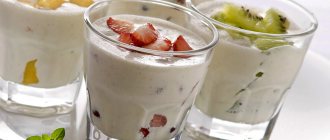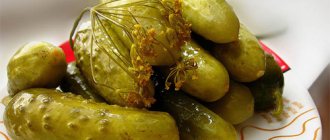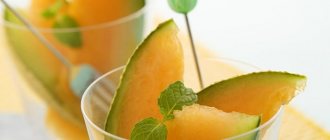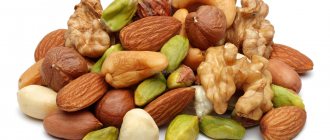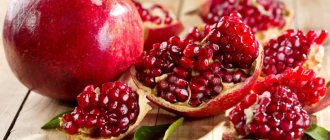Feeding during breastfeeding: 5 key points
First of all, it is worth considering that while the baby consumes breast milk, and it is his only available source of nutrition, the nursing mother has double responsibility. During the lactation period, a woman should seriously concern herself with her own menu, because both the quantity and quality of mother’s milk depend on it and the specific feeding regimen. Here are five basic principles:
- All products must be fresh;
- They must be processed correctly;
- Don’t forget to drink the required amount of fluid;
- Avoid tasty but prohibited foods;
- Constantly monitor the reaction of your body and your baby’s body.
Let's look at each of them separately.
Freshness of products
Breastfeeding presupposes that the mother consumes good quality food, which means only the freshest products, if possible natural, without preservatives. Yesterday's milk or kefir is already beyond what is permitted. Leave anything that has been in the refrigerator for more than 12 hours in the care of other family members.
Proper processing
For a mother who practices breastfeeding, thermally processed foods should predominate in her diet. In the first month after childbirth, cooking is preferable; you can also bake meat and vegetables. Raw foods can cause colic and gas in your baby, so they should be avoided. You should also avoid canned food, homemade pickles, dishes with marinade and overly spicy foods.
More fluid
While a mother is breastfeeding her baby, she should drink more fluids than usual. The daily norm for heated water is 2-2.5 liters. This includes soups, juices, fermented milk drinks, milk and plain water. Half an hour before feeding, it is recommended to drink a glass of warm drink: this will replenish fluid reserves in the body and have a beneficial effect on lactation.
No to allergens!
In the first three weeks of life, it is necessary to exclude from the diet everything that can cause allergies in the baby. Prohibited products: citrus fruits, chocolate, honey, as well as dairy products (including condensed milk, which is mistakenly considered a product that increases lactation).
Observing the reaction
You need to add new products to the menu gradually, in small portions.
It's best to eat a small piece of a new fruit or vegetable in the morning and carefully monitor your baby's well-being throughout the day. In order not to get confused later, you can keep a food diary in which you note the food eaten and the reaction of the baby’s body. Important! If the child is healthy and accepts your nutritional innovations well, then you can gradually return to the usual prenatal diet by the age of three months.
Common misconceptions about breastfeeding and infections
There are a number of misconceptions regarding some infections and their effect on hepatitis B. For example, the presence of a herpes infection in the mother, be it type 1 or type 2, is not a contraindication for breastfeeding . The virus is not transmitted through milk, but protective immunoglobulin is transmitted through milk, which protects the child from infection. Breastfeeding is only prohibited if the rash is localized on the skin of the nipple on the chest. Acute herpes with rashes on the lips and nose, which occurs for the first time, requires a temporary cessation of breastfeeding with isolation of the mother, and the baby must be given expressed milk.
According to WHO, breastfeeding in the presence of hepatitis B does not lead to infection ; it is possible subject to mandatory vaccination of the child after birth and then according to the scheme three more times during the first year of life.
If you have cytomegaloinfection before pregnancy, feeding is not prohibited , the virus is not transmitted through milk, and protective antibodies prevent the child from becoming infected. In the presence of a fresh acute infection, the risk of transmission of infection during hepatitis B is up to 10%, and therefore feeding is prohibited.
note
Infections such as toxoplasmosis, measles, chickenpox, feeding is allowed subject to special rules (administration of immunoglobulin for measles and chickenpox), but in case of hepatitis, typhus or dysentery, feeding cannot be done; the milk is expressed, sterilized and given to the child.
Alena Paretskaya, pediatrician, medical columnist
11 total today
( 193 votes, average: 4.74 out of 5)
Spontaneous milk release
What to do if your child is losing hair?
Related Posts
Foods for breastfeeding by month
It is necessary for a nursing mother to maintain a certain diet during lactation from the first day of the baby’s life. The nutrition chart for a nursing mother by month will tell you when you can introduce a new dish to the menu. The list of products allowed during breastfeeding is compiled based on pediatricians’ observations of the effect of each of them on the child’s body.
| Child's age | Recommended Products | Limited products (2-3 times a week) | Not recommended products |
| 1 week of life | Porridge (buckwheat, oatmeal), boiled beef, soups without frying (vegetable broth), baked apples, dried bread, green apples | Fermented milk drinks (kefir, yogurt), boiled potatoes, cottage cheese, mild cheese | Fresh yeast bread, milk, broths, coffee, fatty fish, citrus fruits, chocolate and chocolate-coated products, sausages, canned food, seafood |
| 1 month | Boiled poultry (turkey, chicken), chicken eggs, biscuits | Bananas, bran, green vegetables, fruit drinks | Premium bread, confectionery baked goods, citrus fruits, fatty fish, spices, store-bought sauces, fast food, carbonated drinks |
| 2 months | Soups with weak poultry/fish broth, boiled fish, fresh vegetable salads (with the exception of brightly colored foods) | Millet porridge, rice, homemade marshmallow, berries/fruits (not red varieties) | Filled pastries, white bread, citrus fruits, cakes, pastries, coffee, cocoa, chocolate, cream, lemonade |
| 3 months | Boiled/baked lean pork, steam cutlets, sour cream, cottage cheese | Vinaigrette, homemade apple/pear jam, compotes | Coffee, cocoa, citrus fruits, chocolate, baked goods, fatty fish, seafood |
| 4+ months | Gradual return to a complete and usual prenatal diet (excluding allergenic and harmful foods) | Fruit salads, casseroles, chicken offal (liver, boiled gizzards) | Sausages, canned foods, fast food, industrial sauces, seafood, chocolate, carbonated drinks |
With proper nutrition of the mother, the natural product contains literally everything that is necessary for the proper growth and development of the baby. Mother's milk undergoes changes every day along with the changing needs of the baby:
- At first, the baby will receive colostrum from the breast, which contains a lot of protein and protective substances, but still little fat. This product is the easiest for a newborn’s digestive system to cope with.
- Approximately 5 days after birth, the mother’s mammary glands begin to produce “transitional” milk. Its amount will be significantly greater than colostrum. There is less protein in this milk, but the amount of fat increases.
- From the 14th day, “mature” milk appears in the mother’s breast. Its composition depends on the diet of the nursing mother, as well as on the frequency of application and even on the time of day. The concentration of nutrients in milk is high, but by 4 months of the child’s life it will gradually decrease, and by 6 months their quantity will no longer be enough regardless of the mother’s nutrition, so the time will come to introduce the first complementary foods.
How to eat properly while breastfeeding (video):
Recipes for mothers while breastfeeding
The diet of a nursing mother is varied, balanced, and safe for the baby. It is important to get all the necessary nutritional and beneficial nutrients from food. The menu should consist of ingredients that can be eaten while breastfeeding.
On a note! The breastfeeding menu should consist of boiled, baked, stewed dishes, fresh vegetables and fruits. It is not advisable for a nursing woman to eat foods that are fried in large amounts of fat, spicy, salty, or overly sweet.
Heat treatment of vegetables is minimal to preserve vitamins and minerals. Meat and fish, on the contrary, should be well boiled or baked. Use spices in limited quantities. Replace refined sugar with honey, dried fruits, and fructose.
Several recipes for dishes while breastfeeding:
Baked millet with pumpkin

- fresh pumpkin – 450 g
- millet – 1 tbsp.
- boiling water – 2 tbsp.
- milk – 2 tbsp.
- egg – 1 pc.
- sugar – 3 tbsp. l.
- drain oil – 2 tbsp. l.
Rinse millet cereals with boiling water several times. Add to boiling water, cook until the liquid has completely evaporated, removing the film. Add hot milk, cook until thickened over low heat.
Peel the pumpkin from peel and seeds. Cut finely. Simmer with a little milk or water and mash with a fork.
Mix puree and porridge. Add egg, sugar, butter. Bake in the oven for 15 minutes.
Meatball soup
- chicken – 500 g
- rice – 0.5 tbsp.
- onion – 1 pc.
- carrots – 1 pc.
- egg – 1 pc.
- greenery
- salt
- water – 2 l
Boil the chicken, grind through a meat grinder, mix with egg, spices, make meatballs.
Add chopped vegetables, washed rice to the broth and cook. In 5 min. add meatballs until the end and add salt. At the end add greens.

Stewed beef with vegetables
- beef – 750 g
- carrots – 1 pc.
- onion – 1 pc.
- celery – 45 g
- vegetable oil – 45 g
- yellow tomato – 1 pc.
- salt
- greenery
Rinse the meat, cut into pieces, lightly fry in oil, add water, simmer for 10 minutes.
Peel and chop the onions and carrots. Add along with the celery to the beef when all the water has evaporated. Fry a little, add chopped tomato, add hot water, salt, add spices to taste. Simmer under the lid closed for 1.5 hours, add water if necessary. Serve sprinkled with herbs.
Cottage cheese casserole
- cottage cheese – 200 g
- egg white – 1 pc.
- sugar – 10 g
- dried fruits - optional
Beat the egg white with a fork and mix with the rest of the ingredients. Place the mixture in a container and bake in the oven for 10 minutes. at 200 0C.

So, the menu of a nursing mother should be complete and balanced, but at the same time, the introduction of new products to the menu should be done with caution; it is recommended to keep a food diary in order to quickly establish the cause of allergic reactions and colic in the baby. If a mother pays great attention to her diet, then breastfeeding will bring only benefit and joy to the baby.
We create a menu: healthy and unhealthy foods for nursing mothers
At first glance, it may seem that it is very difficult to establish nutrition for a nursing mother; many recommendations and rules must be followed. But in fact, everything is very simple - a woman should eat a varied diet, and she should try to ensure that her daily menu includes all food groups. A balanced breakfast, lunch and dinner will meet the needs of both the mother and the breastfed baby.
Meat
This product should be present in the diet of a nursing mother every day, as it is the main source of animal proteins and iron. It is best to cook meat by boiling or stewing. Turkey or chicken should be preferred; beef and lean pork are also suitable. Daily portion – at least 170 g.
Fish
Fish can be included in your breastfeeding diet in the second month after birth. It is better for a nursing mother to eat it boiled, baked, or steamed. You should choose low-fat fish - carp, cod, hake or pike perch. The daily norm is about 70 g and no more than 2-3 times a week.
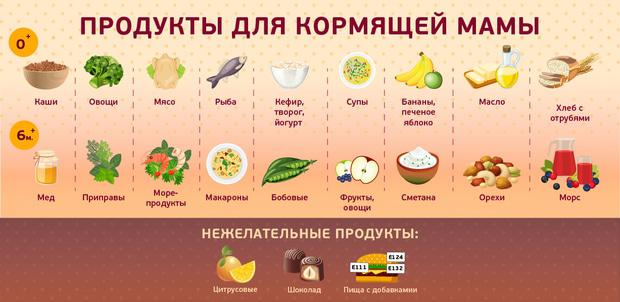
Vegetables and fruits
This is the most important point in nutrition during lactation. Fresh vegetables and fruits contain plant fibers that help intestinal function and prevent constipation in a nursing mother. They are also rich in vitamins and minerals, so they should be included in the menu daily at the rate of 500 g of vegetables (boiled, stewed) and 300 g of thoroughly washed fruits.
On a note! If possible, you should avoid red and orange fruits; they can cause allergies in your baby. These include citrus fruits, strawberries, carrots and red bell peppers.
Milk
It is not recommended to drink whole milk as an independent product - it can cause increased gas formation in the baby. It is better to use it as an additive to main dishes, for example, cook morning porridge with milk or add it to vegetable sauce when stewing. In the third month after childbirth, you can add boiled milk to tea to stimulate lactation.
Dairy products
Cheese and cottage cheese contain a lot of protein and calcium, which are necessary for the proper and complete development of the baby. That is why they are included in the list of products for mandatory consumption during breastfeeding. Moreover, to satisfy the daily requirement during lactation, very little is required: cheese - 15 g, cottage cheese - 50 g. Kefir, natural yogurt without additives, and yogurt are also well absorbed. They have a beneficial effect on the intestinal microflora, do not cause allergies, and create a pleasant feeling of satiety. These drinks can be consumed 1 glass per day.
Bread and cereals
At first after childbirth, cereal dishes will be the main diet for a nursing mother. Cereals are rich in dietary fiber, microelements and vitamins; they can be purchased for future use. With bread, everything is a little different - a white wheat product can cause gas in the baby. You need to choose rye bread made from wholemeal flour to feed your mother.
Oil
During lactation, it is allowed to consume both butter and vegetable oil in moderate quantities. You can lubricate bread with butter or add a piece to porridge. Frying is not recommended, so vegetable oil can be used as a dressing for vegetables in a salad.
The table will help you navigate in choosing the right products to create an individual nutrition plan for a nursing mother.
| Product | Possible with breastfeeding | Possible, but no more than 1-2 times a week | Not allowed during breastfeeding |
| Vegetables | Boiled potatoes, zucchini, broccoli, spinach, squash, lettuce | Cucumbers, eggplants, carrots, beets, pumpkin, cauliflower, turnips | Tomatoes, red and orange bell peppers, onions, garlic, sorrel, radishes, rutabaga, radish |
| Fruits/berries | Green sour apples (fresh, baked), hard pears | Peaches, bananas, apricots | All citrus fruits, grapes, strawberries, raspberries, persimmons, avocado, kiwi |
| Cereals | Oatmeal, rice, buckwheat | Wheat, semolina, corn | Legumes |
| Meat | Boiled or baked chicken fillet, turkey fillet, rabbit meat, lean beef and pork | Chicken liver | Sausages, wieners, sausage, ham, lard, smoked meats, canned meat, pates |
| Fish/seafood | – | Boiled lean fish (hake, pike perch, cod) | All types of seafood (shrimp, squid, mussels, etc.), caviar, fatty fish, Japanese dishes (rolls, sushi) |
| Milk and dairy products | Low-fat cottage cheese, kefir, natural yogurt, yogurt, bifidoc, acidophilus | Cheese, whole milk (in porridge), low-fat sour cream (15%) | Whole milk as a drink, cream, yoghurts with fillings, glazed curd cheeses |
| Bread/pastry | Second-grade rye bread, bran bread, biscuits, dryers | Premium bread, rolls without filling, sweets without cream and glaze | Cream pies, filled pies, cakes |
| Beverages | Boiled water, weak tea (black, green, white), dried fruit compote, infant formula | Homemade jelly (not powder), a decoction of rose hips or herbs for lactation. | Strong meat and fish broths, coffee, cocoa, carbonated drinks, alcohol |
| Other | Boiled chicken eggs, olive and sunflower oil | Pasta, spices (salt, sugar) | Honey, nuts, chocolate, mushrooms, fast food (including crackers, chips), canned food, industrial sauces (ketchup, mayonnaise, mustard), hot herbs and spices |
The nutrition of a nursing mother depends on:
- quantity, quality and taste of milk produced;
- restoration of the maternal body after pregnancy and childbirth;
- resistance to infections and viruses;
- formation of correct eating habits in the baby.
On a note! The caloric content of food during the lactation period for a woman should be 500 kcal higher than in the prenatal period. It should be achieved through a full daily menu, but in no case through bakery and confectionery products (baked goods, sweets), as well as other foods from the forbidden list that are rich in fat.
Breastfeeding diet. Video tips and menus for nursing mothers:
Approximate diet for a mother for a week during lactation
Planning a menu for a new mother can seem like a real challenge - it seems easier to switch to bread and water than to follow all the advice. In order not to get confused about what a nursing mother can eat and what she cannot, we give as an example the weekly diet of those dishes that are allowed during breastfeeding.
| Day of the week | Eating | ||||
| Breakfast | Lunch | Dinner | Afternoon snack | Dinner | |
| Monday | Sandwich with butter and cheese. Weak black tea | Baked egg white omelette. Rose hip decoction | Chicken fillet soup. Zucchini baked with minced meat and rice. Compote | Baked apple, kefir 1% | Steam cutlet, vermicelli casserole with sour cream. Kefir 1% |
| Tuesday | Vermicelli and cottage cheese casserole. Freshly brewed dried fruit compote | Boiled chicken egg, biscuits, tea | Buckwheat soup. Steam cutlet, beet salad. Tea | A glass of plain yogurt, a banana | Boiled cauliflower. Fish stewed in sour cream sauce. Tea |
| Wednesday | Baked apple, weak sweetened tea | Rice pudding, tea | Vegetable puree soup made from potatoes, cauliflower and carrots. Schnitzel, boiled buckwheat. Compote | Cheesecakes baked with low-fat sour cream, tea | Boiled chicken liver, buckwheat porridge. Rose hip decoction |
| Thursday | A cheese sandwich. Dried fruits compote | Milk porridge, compote | Soup in weak fish broth with potatoes. Stewed turkey fillet with vegetables. Rose hip decoction | Cottage cheese with sour cream, tea | Carrot casserole. Steamed chicken cutlet. Kefir 1% |
| Friday | Muesli with natural yoghurt, tea | Oatmeal with apple | Vegetable puree soup. Fresh carrot salad with apple, schnitzel. Dried fruits compote | Baked apple, bifidok | Cottage cheese casserole with low-fat sour cream. Weak tea |
| Saturday | Oatmeal with apple/pear, tea | Fruit salad with natural yogurt | Pumpkin puree soup. Baked meat hedgehogs. Compote | Rice pudding, tea | Vegetable stew, boiled chicken breast. Tea |
| Sunday | Dry bread, apple pastille, weak tea | Cottage cheese casserole with low-fat sour cream | Soup with vermicelli and vegetables. Boiled potatoes with steam cutlet. Rose hip decoction | Biscuits, kefir 1% | Beef stewed with vegetables. Leaf salad. Kefir 1% |
You can take the menu as a basis, varying the recipes at your discretion. Nothing complicated, the main thing is to adhere to the “do no harm” rule - a minimum of spices, without frying or flavoring food with sauces such as mayonnaise. For those who adhere to proper nutrition, there will be nothing new here at all. The dishes are easy to prepare and will not take much time, which is important for the mother of a baby.
Lactation assistants: balanced nutrition for mothers
The production of milk in the breast is a process, although provided for by nature, but in essence it is very complex, and depends on many factors, including psychological ones. There are times when a nursing mother may feel the need to improve lactation. You can cope with the problem of lack of milk: products created specifically for breastfeeding mothers will come to the rescue.
Milk formulas
Powdered milk formulas for mothers are a real salvation when there is insufficient milk production. They are diluted with warm water and taken as an everyday drink, like a cocktail. With regular consumption of the drink (at least 2 glasses a day), milk in the breast increases, moreover, it is enriched with polyunsaturated fatty acids, dietary fiber, vitamins and minerals included in the mixture.
Herbal teas
Special teas for women during the lactation period contain herbs that are allowed in baby food. This is important, because when breastfeeding, everything a mother consumes affects her baby. Such teas include both single components and entire complexes of herbs: lemon balm, cumin, anise, fennel, hibiscus, nettle, verbena and others. Decoctions of these plants increase lactation, help the digestive process of mother and child, help prevent colic and reduce the manifestations of flatulence in babies. Drinking herbal teas has a beneficial effect on the metabolism and emotionality of a nursing mother.
Juices for nursing mothers
Pleasant to the taste, juices for nursing women are enriched with a whole vitamin complex: vitamins C, PP, E, pantothenic and folic acid, biotin and even calcium. Small packages allow you to take these drinks with you and drink them before feeding your baby, even outside the home. Juice for nursing mothers does not contain dyes or preservatives, so it will not cause allergies even in the smallest baby, and the special juice improves lactation and adds variety to the menu.
Vitamin puddings
During the lactation period, sometimes you want to treat yourself to dessert, but almost all delicious sweets are prohibited. But there is a way out! On sale you can find puddings for pregnant and nursing mothers. Thanks to the vitamins, prebiotics and minerals they contain, a nursing mother improves digestion after childbirth and reduces the tendency to constipation. Prebiotics also have a beneficial effect on the immune system.
Breastfeeding nutrition - the experience of a young mother (video):
Breastfeeding at 1 month
In the first month after birth, lactation occurs. Usually colostrum is replaced by milk on the 3rd day. You may feel severe chest fullness, burning, and even fever. It is best to put the baby to the breast more often at this time, and if the areola area becomes very hard, use local cold on the breast and the “back pressure” technique.
Basic rules for breastfeeding at 1 month
The first two weeks of breastfeeding
Babies develop their own feeding routine. In this case, it is better for the mother to ensure that the baby suckles at the breast at least once every 2 hours during the day and once every 3-4 hours at night.
If the baby sleeps for more than two hours during the day, it is better to gently wake him up and put him to the chest, for example, unswaddle him, remove the diaper and lay him on his chest in skin-to-skin contact.
As a rule, after 2 weeks of breastfeeding, babies leave after birth
and begin to wake up on their own more often than before. Now feedings can be every 40 minutes or even more often. This frequency is normal if the child is gaining weight well. By two weeks the baby should reach its birth weight. In general, there is a separate detailed article on weight gain on this site - read it!
Duration of feeding in the 1st month
can also be very different: from 15 to 90 minutes.
The fact is that babies in the early postpartum period need prolonged sucking to compensate for the stress after birth and solve any other discomfort. Therefore, having sucked most of the milk from the breast, they fall asleep and suck very lazily in their sleep, which allows them to quickly calm down, feel one with their mother and prolong their sleep.
Unproductive breastfeeding at 1 month
It is also important for further stimulation of milk production. Some women are afraid that in this way they will teach their children to sleep with the breast in their mouth or damage their nipples. This is wrong. If the baby latches onto the breast deeply and the woman is not in pain throughout the feeding, then the nipples are not injured even with very long sucking. Sucking at the breast while sleeping is not a habit, but a need for all little children!
Already by 2 weeks in the first month of breastfeeding, you can feel the first decline in breast fullness
. This is a normal phenomenon with frequent feedings on demand and is not a sign of a lactation crisis, as is commonly believed. The breast simply begins to adapt to the child’s needs.
Continue to feed as your baby demands and allow him to stay at the breast for as long as he wants. It is advisable that every time the baby falls asleep with the breast, and not with a pacifier or from motion sickness in a stroller.
There is no need to stand the baby up every time after feeding. Alternate breasts as often as you like. Don’t let the problem of hindmilk worry you either - after all, the more often you feed, the faster the baby gets to the hindmilk.

